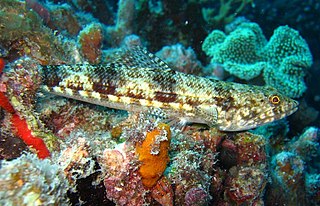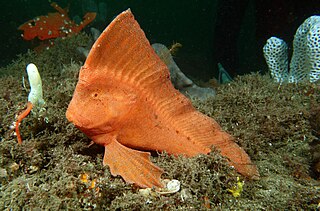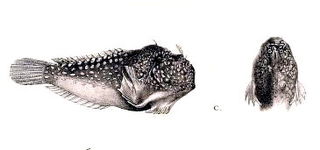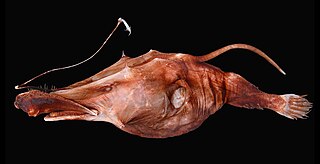
The Amblyopsidae are a fish family commonly referred to as cavefish, blindfish, or swampfish. They are small freshwater fish found in the dark environments of caves, springs and swamps in the eastern half of the United States. Like other troglobites, most amblyopsids exhibit adaptations to these dark environments, including the lack of functional eyes and the absence of pigmentation. More than 200 species of cavefishes are known, but only six of these are in the family Amblyopsidae. One of these, Forbesichthys agassizii, spends time both underground and aboveground. A seventh species in this family, Chologaster cornuta, is not a cave-dweller but lives in aboveground swamps.

Barracudinas are any member of the marine mesopelagic fish family Paralepididae: 50 or so extant species are found almost worldwide in deep waters. Several genera are known only from fossils dating back to the Ypresian epoch.

Aulopiformes is a diverse order of marine ray-finned fish consisting of some 15 extant and several prehistoric families with about 45 genera and over 230 species. The common names grinners, lizardfishes and allies, or aulopiforms are sometimes used for this group. The scientific name means "Aulopus-shaped", from Aulopus + the standard fish order suffix "-formes". It ultimately derives from Ancient Greek aulós + Latin forma, the former in reference to the elongated shape of many aulopiforms.

Greeneyes are deep-sea aulopiform marine fishes in the small family Chlorophthalmidae. Thought to have a circumglobal distribution in tropical and temperate waters, the family contains just 18 species in two genera. The family name Chlorophthalmidae derives from the Greek words chloros meaning "green" and ophthalmos meaning "eye".

Sabertooth or sabretooth fish are small, fierce-looking deep-sea aulopiform fish comprising the family Evermannellidae. The family is small, with just eight species in three genera represented; they are distributed throughout tropical to subtropical waters of the Atlantic, Indian, and Pacific Oceans.

The footballfish form a family, Himantolophidae, of globose, deep-sea anglerfishes found in tropical and subtropical waters of the Atlantic, Indian, and Pacific Ocean. The family contains 23 species, all of which are classified in a single genus, Himantolophus.

The Ipnopidae are a family of fishes in the order Aulopiformes. They are small, slender fishes, with maximum length ranging from about 10 to 40 cm. They are found in temperate and tropical deep waters of the Atlantic, Indian, and Pacific Oceans.

Ogcocephalidae is a family of anglerfish specifically adapted for a benthic lifestyle of crawling about on the seafloor. Ogcocephalid anglerfish are sometimes referred to as batfishes, deep-sea batfishes, handfishes, and seabats. They are found in tropical and subtropical oceans worldwide. They are mostly found at depths between 200 and 3,000 m, but have been recorded as deep as 4,000 m (13,000 ft). A few species live in much shallower coastal waters and, exceptionally, may enter river estuaries.

The Australian prowfishes are a small family, the Pataecidae, of ray-finned fishes classified within the order Scorpaeniformes. Australian prowfishes are distinguished by a long dorsal fin that begins far forward on the head, forming a "prow" shape, and extends all the way to the caudal fin. They lack scales and pelvic fins.

Tetrabrachiidae, or the four-armed frogfishes or doublefin frogfishes, is a small family of marine ray-finned fishes belonging to the suborder Antennarioidei in the order Lophiiformes, the anglerfishes. These fishes are found in relatively shallow waters of the eastern Indian Ocean and western Pacific Ocean.

Lasiognathus, the wolftrap anglerfish, is a genus of deep-sea anglerfish in the family Thaumatichthyidae, with six species known from the Atlantic and Pacific Oceans.

The Aulopidae are a small family of aulopiform ray-finned fish. They are found in most tropical and subtropical oceans, and are commonly known as flagfins.

The Pacific barreleye fish (Macropinna) is a genus of ray-finned fish belonging to Opisthoproctidae, the barreleye family. It contains one species, M. microstoma. It is recognized for a highly unusual transparent, fluid-filled shield on its head, through which the lenses of its eyes can be seen. It was originally believed that the tubular eyes of this fish were fixed in place and, therefore, only provided a tunnel vision view of what was seen above its head. However, in 2008, scientists discovered that its eyes were able to rotate both up and forward in its transparent shield. M. microstoma has a tiny mouth and most of its body is covered in large scales. The fish normally hangs nearly motionless in the water, at a depth of about 600 metres (2,000 ft) to 800 metres (2,600 ft), using its large fins for stability and with its eyes directed upward. In the low light conditions it is assumed the fish detects prey by its silhouette. This is because the eyes have no lens in the diverticulum, so images would most likely occur through reflection. Due to the eyes facing upwards, light is able to enter the eyes and through the illumination, silhouettes are formed. MBARI researchers Bruce Robison and Kim Reisenbichler observed that when prey such as small fish and jellyfish are spotted, the eyes rotate like binoculars, facing forward as it turns its body from a horizontal to a vertical position to feed. Robison speculates that M. microstoma steals food from siphonophores.

Bufoceratias wedli is a species of deep sea marine ray-finned fish belonging to the family Diceratiidae, the double anglers. This anglerfish is found in deep water over the continental shelf in the tropical and subtropical areas of the Eastern and Western Atlantic Oceans. It is the type species of the genus Bufoceratias and like other members of that genus is known only from adult females, the unknown males are thought to be free living rather than sexual parasites of the females like those of some other deep sea anglerfishes.

Vision is an important sensory system for most species of fish. Fish eyes are similar to the eyes of terrestrial vertebrates like birds and mammals, but have a more spherical lens. Birds and mammals normally adjust focus by changing the shape of their lens, but fish normally adjust focus by moving the lens closer to or further from the retina. Fish retinas generally have both rod cells and cone cells, and most species have colour vision. Some fish can see ultraviolet and some are sensitive to polarised light.
Benthalbella is a genus of pearleyes.

Diceratias is a genus of deep sea marine ray-finned fish belonging to the family Diceratiidae, the double anglers. These fishes are found in the Eastern Atlantic and Indo-Pacific regions.
Dibrachichthys is a monospecific genus belonging to the family Tetrabrachiidae, the four-armed frogfishes. The only species in the genus is Dibrachichthys melanurus, the twoarm humpback anglerfish, which is found in the eastern Indian and western Pacific Oceans.
Lagiacrusichthys macropinna, the longfin greeneye, is a species of pearleye and the only species in the genus Lagiacrusichthys. L. macropinna live between 0–840 m depth, usually 500 m. This species occurs in Antarctic waters. This species is the only known member of its genus. The genus is named after the fictional monster Lagiacrus from the Monster Hunter video game series and franchise, as both are "rather ferocious coldwater predators" that inhabit the deep ocean.
Scopelarchus analis, the short fin pearleye or blackbelly pearleye, is a species of ray-finned fish that can be found circumglobal in warm waters. It is a member of the Scopelarchus, a genus of pearleyes.
















